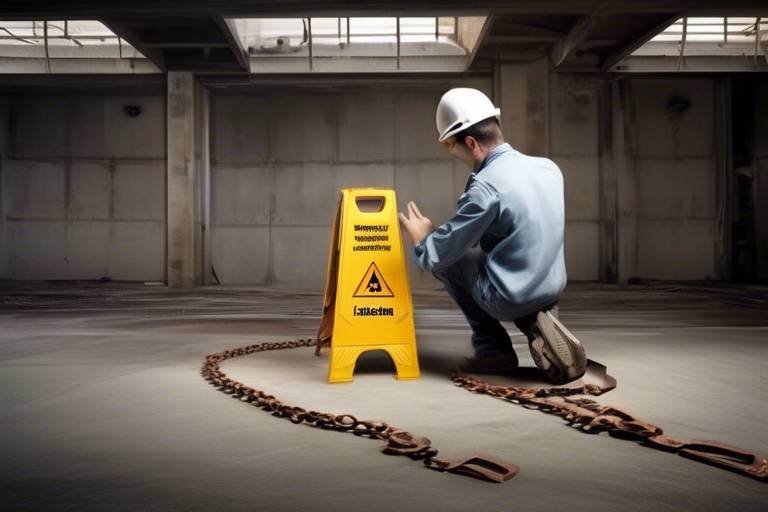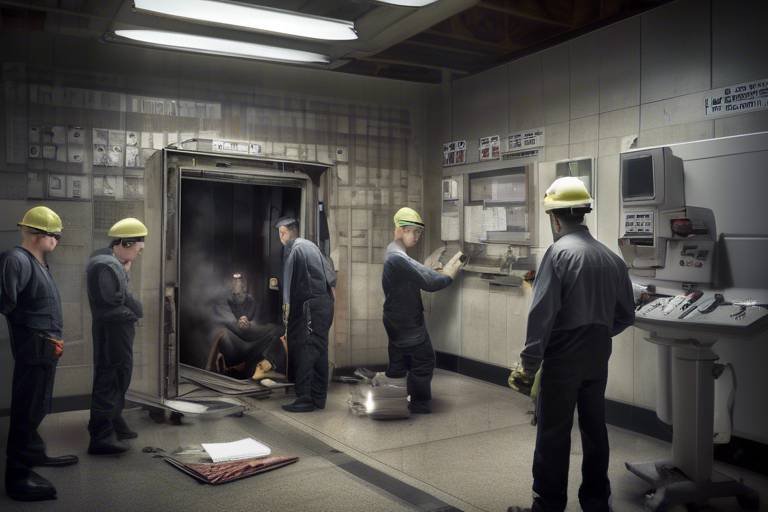The Profound Impact of Human Behavior on Safety
Human behavior is a fascinating and complex phenomenon, profoundly influencing safety in various environments. Whether we're talking about workplaces, public spaces, or even our homes, the way people act and react can either enhance or undermine safety protocols. Have you ever thought about how a simple decision, like choosing to wear a seatbelt, can mean the difference between life and death? It’s not just about rules; it’s about the choices we make every day.
The interplay between human behavior and safety is a multifaceted issue. It encompasses psychological factors, social dynamics, and even cultural influences. For instance, consider how risk perception varies from person to person. Some individuals might underestimate the dangers of texting while driving, while others may be overly cautious about walking in a crowded area. Why does this disparity exist? It often stems from our individual experiences, emotional responses, and the societal norms that surround us.
Moreover, the decision-making process is heavily influenced by emotions. When faced with a stressful situation, our instincts can either guide us toward safe choices or lead us into perilous territory. This emotional aspect of safety behavior is critical. It’s not merely about knowing what to do; it’s about feeling empowered to take action. For example, in a fire emergency, a person who feels calm and informed is more likely to evacuate safely than someone who panics. This highlights the importance of not just educating individuals about safety protocols, but also fostering a mindset that encourages proactive behavior.
Furthermore, social dynamics play a pivotal role in shaping our safety behaviors. Peer pressure can either encourage safe practices or induce risky behaviors, depending on the group’s norms. Think about it: if everyone in your workplace wears safety gear, you’re more likely to do the same. Conversely, if you notice colleagues skirting safety regulations, you might feel tempted to follow suit. This is where leadership becomes essential. Strong leaders can cultivate a culture of safety, where everyone feels responsible for their own well-being and that of their peers. They can set the tone for safety behaviors and create an environment where individuals feel supported in making safe choices.
In summary, the profound impact of human behavior on safety cannot be overstated. From psychological factors to social influences, our actions and decisions shape the safety landscape around us. By understanding these dynamics, we can develop more effective safety measures that resonate with individuals on a personal level, ultimately leading to a safer world for everyone.
- How does human behavior affect workplace safety?
Human behavior significantly impacts workplace safety through decision-making, adherence to safety protocols, and the influence of social dynamics among colleagues.
- What role does training play in improving safety behavior?
Training equips individuals with the knowledge and skills needed to respond effectively to safety challenges, fostering a culture of safety awareness and proactive behavior.
- How can technology enhance safety measures?
Technology, such as AI and wearable devices, helps monitor conditions and predict risks, allowing for timely interventions that enhance overall safety.

The Psychology of Safety
Understanding the psychological factors that drive human behavior is crucial for enhancing safety in any environment. At the core of safety psychology lies risk perception, which refers to how individuals evaluate the likelihood of danger. Have you ever thought about why some people take unnecessary risks while others are overly cautious? This discrepancy often stems from personal experiences, cultural backgrounds, and even emotional states. For instance, someone who has witnessed a serious accident may develop a heightened sense of awareness, leading them to adopt safer practices. Conversely, individuals who have never encountered danger might underestimate risks, believing they are invincible.
Another significant aspect to consider is the decision-making process in safety-related scenarios. When faced with potential hazards, people often rely on heuristics—mental shortcuts that simplify decision-making. While these can be efficient, they can also lead to errors in judgment. Imagine being in a crowded space where an emergency arises. Your instinct might be to flee, but what if that instinct overrides a more rational assessment of the safest exit? This illustrates how emotions can cloud our judgment, sometimes leading us away from the safest choices.
Moreover, emotions play a pivotal role in influencing safety behavior. Fear, anxiety, and even overconfidence can dictate how we respond to threats. For example, fear might compel someone to wear a helmet while biking, while overconfidence could lead another to ride without one, believing they are skilled enough to avoid accidents. Thus, understanding these emotional triggers is key to designing interventions that promote safer behaviors.
To further illustrate these concepts, consider the following table that summarizes the psychological factors influencing safety behavior:
| Psychological Factor | Impact on Safety Behavior |
|---|---|
| Risk Perception | Affects how individuals assess dangers and decide on safety measures. |
| Decision-Making | Influences choices during emergencies; can lead to quick but potentially unsafe decisions. |
| Emotional State | Can enhance or diminish awareness of risks, affecting overall safety practices. |
In summary, the psychology of safety is a complex interplay of risk perception, decision-making processes, and emotional influences. By understanding these factors, we can create more effective safety programs that not only address the physical aspects of safety but also resonate with the human experience. This understanding allows us to tailor our approaches, ensuring that safety measures are not just rules to follow but principles that resonate with individuals on a deeper level.
- What is risk perception? Risk perception is how individuals evaluate the likelihood of danger based on their experiences and emotions.
- How do emotions affect safety behavior? Emotions can cloud judgment, leading to either heightened awareness or overconfidence in dangerous situations.
- Why is decision-making important in safety? Decision-making processes can significantly impact how individuals respond to emergencies, influencing their safety choices.

The Role of Training and Education
When it comes to enhancing safety in any environment, training and education play a pivotal role. Imagine stepping into a workplace where every individual is not only aware of the safety protocols but also actively engaged in practicing them. This is the power of effective training programs. They equip employees with the necessary skills and knowledge to identify potential hazards, make informed decisions, and respond appropriately in emergencies.
One of the most significant aspects of training is its ability to shape behavior. Through structured learning experiences, individuals can grasp the importance of safety measures and internalize them as part of their daily routines. For instance, regular safety drills not only prepare employees for real-life scenarios but also foster a culture of safety within the organization. When everyone is on the same page, the likelihood of accidents diminishes significantly.
Moreover, training is not a one-time event; it is an ongoing process. Organizations that prioritize continuous education find that their teams are more adaptive to new challenges and technologies. This adaptability is crucial in today’s rapidly changing work environments, where new safety risks can emerge from evolving technologies or practices. By implementing ongoing training programs, companies can ensure their workforce remains vigilant and informed.
In addition, various training methods can be employed to cater to different learning styles. Some individuals may benefit from hands-on experiences, while others might prefer classroom instruction or online courses. The key is to provide a mix of these approaches to maximize engagement and retention. For example, a combination of interactive workshops and e-learning modules can create a comprehensive training experience that addresses diverse needs.
Furthermore, integrating real-world scenarios into training can significantly enhance its effectiveness. By using case studies or simulations, employees can practice their responses to potential hazards in a controlled environment. This not only builds confidence but also helps them understand the consequences of their actions. The more realistic the training, the better prepared individuals will be when faced with actual safety challenges.
To illustrate the impact of training on safety behavior, consider the following table that outlines key statistics from various industries:
| Industry | Pre-Training Incident Rate | Post-Training Incident Rate | Improvement (%) |
|---|---|---|---|
| Construction | 12.5 | 7.2 | 42.8 |
| Manufacturing | 9.8 | 5.1 | 48.0 |
| Healthcare | 15.3 | 10.6 | 30.7 |
This table clearly demonstrates that effective training can lead to substantial improvements in safety outcomes across various sectors. As the incident rates drop, not only does the workplace become safer, but employees also feel more secure and valued, fostering a positive work environment.
In conclusion, the role of training and education in promoting safety cannot be overstated. By investing in comprehensive training programs, organizations can cultivate a safety-conscious culture that empowers employees to take ownership of their safety and that of their colleagues. Ultimately, a well-trained workforce is the backbone of a safe and productive environment.
- What is the most effective training method for safety? The effectiveness of a training method can vary based on the audience. A mix of hands-on training, simulations, and e-learning often yields the best results.
- How often should safety training be conducted? Regular training sessions, ideally quarterly or bi-annually, ensure that employees remain updated on safety protocols and practices.
- Can technology enhance safety training? Absolutely! Technology such as virtual reality and online modules can provide immersive training experiences that engage learners effectively.

Behavioral safety programs are a proactive approach designed to modify unsafe behaviors in various environments, particularly in the workplace. These programs focus on the observation and feedback of individuals’ actions, aiming to create a culture that prioritizes safety. Think of it as a coaching session where the goal is to enhance performance—not just in sports, but in everyday tasks that could potentially lead to accidents. By fostering an atmosphere where safety is everyone's responsibility, organizations can significantly reduce incidents and improve overall morale.
At the heart of behavioral safety programs lies the principle of continuous improvement. This means that safety is not just a one-time training session but an ongoing process that requires attention and commitment. The programs typically involve several key components:
- Observation: Trained observers watch employees as they perform their tasks, noting both safe and unsafe behaviors.
- Feedback: Constructive feedback is provided to employees, reinforcing safe practices and addressing unsafe behaviors.
- Participation: Employees are encouraged to participate in discussions about safety, allowing them to voice concerns and suggest improvements.
- Measurement: Safety performance is regularly measured to track progress and identify areas needing attention.
One of the most compelling aspects of behavioral safety programs is their emphasis on peer influence. When employees see their coworkers prioritizing safety, they are more likely to follow suit. This creates a ripple effect, as safe behaviors become the norm rather than the exception. To illustrate this, consider a workplace where one employee consistently wears their protective gear. Over time, this individual’s actions may inspire others to adopt similar habits, leading to a safer environment for all.
However, it's important to recognize that implementing these programs is not without its challenges. Some employees may resist change, viewing safety protocols as an inconvenience rather than a necessity. To combat this, organizations must cultivate a culture of trust and open communication. When employees feel valued and understood, they are more likely to embrace behavioral safety initiatives. Additionally, leadership plays a crucial role in modeling safe behaviors and reinforcing the importance of safety protocols.
Several organizations have successfully implemented behavioral safety programs, leading to remarkable improvements in safety performance. For instance, a manufacturing plant that adopted such a program saw a 40% reduction in workplace accidents within the first year. This success story highlights the tangible benefits of focusing on human behavior as a key factor in safety management.
In conclusion, behavioral safety programs represent a vital strategy for enhancing safety in various settings. By focusing on observation, feedback, and the influence of social dynamics, these programs not only reduce accidents but also foster a culture of safety that benefits everyone involved. As we continue to explore the profound impact of human behavior on safety, it becomes clear that investing in these programs is not just a smart choice—it's a necessary one for any organization committed to protecting its workforce.

Case Studies of Success
When it comes to enhancing safety through behavioral programs, real-world examples speak volumes. Let’s dive into a few case studies that demonstrate the profound impact of behavioral safety initiatives. These examples not only highlight the effectiveness of such programs but also provide valuable insights into how they can be implemented across various industries.
One remarkable case is that of a major manufacturing company that faced high rates of workplace accidents. After conducting a thorough analysis, they implemented a behavioral safety program aimed at modifying unsafe behaviors. The program included regular safety observations, feedback sessions, and the establishment of safety champions among employees. Within one year, the company reported a 60% reduction in workplace injuries. This success was attributed to the employees feeling more empowered to speak up about unsafe practices and the continuous positive reinforcement they received.
Another compelling example comes from the construction sector. A large construction firm faced challenges with safety compliance on job sites, leading to numerous incidents. By introducing a comprehensive training program that emphasized the importance of safety behaviors, combined with on-site coaching, they saw a dramatic shift in the safety culture. Employees were encouraged to participate in safety audits and were rewarded for identifying potential hazards. As a result, the firm experienced a 50% decrease in safety incidents over two years, showcasing how proactive engagement can lead to significant improvements.
In the healthcare industry, a hospital implemented a behavioral safety initiative focusing on hand hygiene compliance. Staff members were trained not just on the importance of handwashing but also on the emotional aspects of patient safety. They created a peer observation system where colleagues would gently remind each other about hygiene practices. This approach led to a remarkable increase in compliance rates, from 70% to 95% within six months. Such cases underline that when employees are involved and invested in safety, the outcomes can be transformative.
To further illustrate the effectiveness of behavioral safety programs, here’s a summary of key outcomes from these case studies:
| Industry | Company | Initial Issue | Outcome |
|---|---|---|---|
| Manufacturing | Major Manufacturing Co. | High workplace accidents | 60% reduction in injuries |
| Construction | Large Construction Firm | Safety compliance challenges | 50% decrease in incidents |
| Healthcare | Local Hospital | Low hand hygiene compliance | Compliance increased from 70% to 95% |
These case studies not only highlight the success of behavioral safety programs but also showcase the importance of a tailored approach that considers the unique challenges of each industry. By focusing on modifying behaviors and fostering a culture of safety, organizations can achieve remarkable results. The key takeaway is clear: when people are engaged and educated about safety, the benefits extend far beyond compliance; they create a safer, more productive environment for everyone involved.
Q: What are behavioral safety programs?
A: Behavioral safety programs focus on identifying and modifying unsafe behaviors in the workplace through observation, feedback, and training.
Q: How can I implement a behavioral safety program in my organization?
A: Start by assessing your current safety practices, involve employees in the process, provide training, and establish a system for feedback and recognition of safe behaviors.
Q: Are there specific industries that benefit more from these programs?
A: While all industries can benefit, high-risk sectors like construction, manufacturing, and healthcare often see significant improvements in safety outcomes.
Q: How do technology and behavioral safety programs work together?
A: Technology can enhance behavioral safety programs by providing tools for monitoring, data collection, and analysis, thereby helping organizations to identify trends and areas for improvement.

Challenges in Implementation
Implementing behavioral safety programs is not just a walk in the park; it comes with its own set of hurdles that can make even the most seasoned safety professionals scratch their heads. One of the biggest challenges is often the resistance to change. Employees may be set in their ways, and altering their behavior can feel like trying to turn a massive ship in a narrow canal. This resistance can stem from a variety of factors, such as fear of the unknown or a simple lack of motivation to adopt new practices.
Another significant hurdle is the inconsistent application of safety protocols. Even when a program is implemented, it may not be uniformly enforced across all departments or teams. Imagine a workplace where some employees diligently follow safety guidelines while others ignore them; this inconsistency can lead to confusion and, ultimately, increased risk. To combat this, organizations must ensure that all employees receive the same level of training and understanding regarding safety protocols.
Furthermore, insufficient resources can stall the implementation process. Whether it’s a lack of funding for training sessions or inadequate tools to monitor safety practices, the absence of necessary resources can severely limit the effectiveness of behavioral safety programs. Organizations often find themselves caught in a vicious cycle where inadequate resources lead to poor safety practices, which in turn leads to more accidents and even greater resource allocation challenges.
Moreover, the measurement of success poses another challenge. How do you quantify the effectiveness of a behavioral safety program? Relying on anecdotal evidence can be misleading, and without concrete data, it becomes difficult to justify continued investment in these programs. To address this, companies need to develop robust metrics that can accurately reflect safety improvements and behavioral changes over time.
Lastly, leadership buy-in is crucial for the success of any safety initiative. If management is not fully committed to the program, it can lead to a lack of motivation among employees. When leaders actively participate in safety training and demonstrate their commitment to the cause, it sets a powerful example for everyone else. In contrast, if leaders are disengaged, it can create a culture where safety is seen as a mere checkbox rather than a fundamental aspect of the workplace.
In summary, while behavioral safety programs have the potential to significantly enhance workplace safety, their implementation is fraught with challenges. Addressing resistance to change, ensuring consistent application, allocating sufficient resources, measuring success accurately, and securing leadership buy-in are all critical steps that organizations must take to overcome these hurdles. Only then can they create a safer and more productive work environment.
- What are behavioral safety programs?
These programs focus on modifying unsafe behaviors through observation and feedback to enhance workplace safety.
- Why is leadership buy-in important?
Leadership buy-in ensures that safety initiatives are taken seriously and motivates employees to engage with safety protocols.
- How can organizations measure the success of safety programs?
Organizations can develop metrics based on incident reports, employee feedback, and training completion rates to evaluate the effectiveness of their safety programs.
- What are some common barriers to implementing safety programs?
Common barriers include resistance to change, inconsistent application of protocols, insufficient resources, and lack of leadership support.

Social Influences on Safety Behavior
When we think about safety, we often focus on individual actions and decisions. However, the truth is that social influences play a monumental role in shaping how we behave in various environments. Just like a pebble thrown into a pond creates ripples, our social circles can significantly affect our safety practices—sometimes for better, sometimes for worse. Have you ever noticed how your friends' attitudes towards safety can impact your own? This phenomenon is rooted in the complex web of peer pressure, group norms, and leadership dynamics.
Peer pressure is a powerful force that can either encourage safe behavior or lead to risky actions. For instance, if a group of friends decides to ignore safety protocols during an outing, an individual may feel compelled to follow suit, even if they know better. This can be particularly evident in high-stakes environments like construction sites or laboratories, where the pressure to conform can overshadow personal judgment. In these situations, the desire to fit in can outweigh the instinct to prioritize safety, leading to potentially dangerous consequences.
Moreover, group norms establish a baseline for acceptable behavior within any given social setting. When safety becomes a shared value among peers, individuals are more likely to adopt safer practices. Think of it this way: if everyone in your workplace is committed to wearing safety gear, you’re more likely to do the same. This collective commitment can create a culture of safety that promotes accountability and encourages individuals to look out for one another. However, if the norm leans towards complacency, it can be equally challenging to shift behaviors back to a safer standard.
Leadership also plays a crucial role in influencing safety behavior. Leaders who prioritize safety and model safe practices can inspire their teams to follow suit. Imagine a manager who consistently emphasizes the importance of wearing helmets on a construction site; their commitment can motivate workers to adopt the same mindset. Conversely, a lack of leadership in safety can lead to a culture that undervalues these essential practices. It’s like a ship without a captain—without guidance, the crew may steer off course.
To illustrate the impact of social influences on safety behavior, consider the following table:
| Social Influence | Effect on Safety Behavior |
|---|---|
| Peer Pressure | Can lead to risky behaviors or foster a culture of safety, depending on the group. |
| Group Norms | Establishes standards for safety practices, influencing individual choices. |
| Leadership | Sets the tone for safety culture; effective leaders inspire safe practices. |
In summary, understanding the social influences on safety behavior is essential for creating effective safety strategies. By recognizing how peer dynamics, group norms, and leadership impact our actions, we can develop interventions that promote safer behaviors across various settings. So next time you find yourself in a situation where safety is at stake, consider the social dynamics at play—because sometimes, it's not just about what you do, but who you do it with!
- How does peer pressure affect safety behavior? Peer pressure can lead individuals to conform to unsafe practices or encourage them to adopt safer behaviors, depending on the attitudes of their social group.
- What role do group norms play in safety? Group norms establish a baseline for acceptable behavior; when safety is prioritized within a group, individuals are more likely to follow suit.
- How can leaders influence safety in the workplace? Leaders who model safe practices and emphasize the importance of safety can inspire their teams to adopt similar attitudes and behaviors.

Technology's Role in Enhancing Safety
In today's fast-paced world, the integration of technology into safety protocols has become not just beneficial but essential. Imagine a workplace where potential hazards are monitored in real-time, or a personal device that alerts you to dangerous conditions before they escalate. This is the power of technology in enhancing safety measures across various environments. By leveraging innovative tools, organizations and individuals can proactively manage risks, ensuring a safer atmosphere for everyone involved.
One of the most significant advancements in safety technology is the use of artificial intelligence (AI) and predictive analytics. These technologies analyze vast amounts of data to identify patterns and predict potential safety incidents before they occur. For instance, AI can process historical data from various sources, such as employee reports, environmental conditions, and equipment performance, to forecast when and where accidents are likely to happen. By anticipating risks, organizations can implement preventive measures, thus reducing the likelihood of incidents.
Moreover, wearable safety devices have emerged as game-changers in personal safety. These gadgets, which can be worn on the body, monitor health metrics such as heart rate, body temperature, and even environmental conditions like air quality. For example, construction workers can wear smart helmets equipped with sensors that detect dangerous levels of gases or alert them to falling objects. The real-time feedback provided by these devices not only enhances individual safety but also fosters a culture of safety awareness among teams.
To illustrate the impact of technology on safety, consider the following table that outlines some key technological advancements and their benefits:
| Technology | Benefits |
|---|---|
| Wearable Safety Devices | Real-time monitoring of health and environmental conditions, immediate alerts to potential hazards. |
| AI and Predictive Analytics | Data-driven insights to anticipate risks, improved decision-making for safety measures. |
| Safety Apps | Easy reporting of safety issues, access to safety resources, and training materials. |
| Smart Surveillance Systems | Enhanced monitoring of premises, quick identification of unsafe behaviors or situations. |
Additionally, safety apps have become increasingly popular, providing users with the ability to report safety concerns instantly. These applications often include features that allow employees to document incidents, access safety protocols, and receive training materials right from their smartphones. This level of accessibility ensures that everyone is equipped with the knowledge they need to maintain a safe environment.
However, while technology has revolutionized safety practices, it is essential to recognize that these tools are most effective when integrated with a strong safety culture. Technology should not replace human judgment or interaction; rather, it should enhance our ability to make informed decisions. Training staff on how to effectively use these technologies is crucial. After all, a smart device is only as effective as the person using it!
In conclusion, the role of technology in enhancing safety is undeniable. From AI and wearables to safety apps and smart surveillance systems, these advancements empower individuals and organizations to take proactive steps toward a safer future. As we continue to innovate, the potential for improving safety measures will only grow, making it imperative for everyone to embrace these changes.
- How can AI improve safety in the workplace?
AI can analyze data to predict potential hazards, allowing organizations to implement preventive measures before incidents occur. - What are wearable safety devices?
These are gadgets worn on the body that monitor health metrics and environmental conditions to enhance personal safety. - Are safety apps effective?
Yes, safety apps provide instant reporting capabilities and access to safety resources, promoting a culture of safety awareness. - How important is training in using safety technology?
Training is crucial as it ensures that employees understand how to use safety technologies effectively, maximizing their benefits.

Wearable Safety Devices
In today's fast-paced world, are becoming essential tools for enhancing personal safety. These innovative gadgets, which can be worn on the body like clothing or accessories, are designed to monitor various health and environmental conditions, providing users with real-time data that can prevent accidents and promote well-being. Imagine having a personal safety assistant that fits snugly on your wrist or clipped to your clothing, constantly alerting you to potential dangers. Sounds futuristic, right? But it's happening now!
Wearable safety devices come in many forms, from smartwatches that track heart rates and activity levels to specialized sensors that detect hazardous environments. For instance, construction workers might wear helmets equipped with sensors that monitor exposure to harmful gases, while athletes could use fitness trackers that alert them to signs of overexertion. The versatility of these devices makes them applicable in various settings, including workplaces, recreational activities, and everyday life.
One of the most significant advantages of wearable safety devices is their ability to provide immediate alerts. For example, a smart helmet used in construction sites can notify the wearer if they are entering a hazardous area or if their oxygen levels are dropping. This instant feedback can be the difference between a close call and a serious accident. Moreover, many of these devices are equipped with GPS technology, which can help locate individuals in case of an emergency, ensuring swift assistance when it’s needed most.
Furthermore, the integration of health monitoring features in these devices is particularly noteworthy. Many wearables can track vital signs such as heart rate, body temperature, and even stress levels. This data can be invaluable for identifying health issues before they escalate into emergencies. For example, a construction worker who is overexerting themselves might receive a notification to take a break, potentially preventing heat exhaustion or injury.
However, the effectiveness of wearable safety devices greatly depends on user engagement and education. It's crucial for individuals to understand how to use these devices properly to maximize their benefits. Training sessions that focus on the functionality of these gadgets can empower users, ensuring they know how to respond to alerts and utilize the data provided. This educational aspect is vital in fostering a culture of safety, where individuals are proactive about their well-being.
As we continue to embrace technological advancements, the future of wearable safety devices looks promising. With ongoing innovation, we can expect even more sophisticated features, such as AI integration that learns user habits and predicts potential risks. This could lead to a more personalized safety experience, where devices not only react to dangers but also anticipate them based on user behavior and environmental factors.
In conclusion, wearable safety devices are not just a trend; they are a significant leap towards enhancing personal safety in various environments. By providing real-time data, alerts, and health monitoring, these devices empower individuals to take charge of their safety. As technology evolves, we can only imagine the incredible advancements that lie ahead, making our world a safer place, one wearable device at a time.
- What types of wearable safety devices are available? There are various types, including smartwatches, fitness trackers, smart helmets, and specialized sensors designed for specific industries.
- How do wearable safety devices improve safety in the workplace? They provide real-time alerts about hazardous conditions, monitor vital signs, and can help locate individuals in case of emergencies.
- Are wearable safety devices effective for personal use? Absolutely! They can monitor health and fitness levels, alert users to potential dangers, and promote overall well-being.
- Do I need training to use these devices? While many devices are user-friendly, training can enhance your understanding and ensure you make the most of their features.

AI and Predictive Analytics
Artificial Intelligence (AI) and predictive analytics are not just buzzwords; they are revolutionizing the way we approach safety management across various industries. Imagine walking into a workplace where potential hazards are identified before they even occur—this is the power of AI. By analyzing vast amounts of data, AI systems can forecast risks and provide actionable insights that help organizations implement proactive safety measures. But how does this actually work?
At its core, predictive analytics uses algorithms and statistical models to analyze historical data and predict future outcomes. For instance, in a manufacturing setting, data from past incidents can be analyzed to identify patterns that lead to accidents. By recognizing these patterns, organizations can adjust their safety protocols accordingly, potentially saving lives and reducing costs.
Consider this scenario: a factory notices a spike in machinery-related injuries over the past few months. With AI, they can dig deep into the data to uncover the root causes—perhaps specific machines are malfunctioning more frequently or certain shifts are more prone to accidents. This level of insight allows management to take targeted actions, such as scheduling maintenance for faulty machines or providing additional training for employees during high-risk shifts.
Moreover, AI-driven tools can continuously monitor real-time data from various sources, including sensors and wearables, to provide instant alerts about unsafe conditions. For example, if a worker is exposed to hazardous levels of noise or chemicals, the system can send immediate warnings, allowing for quick intervention. This proactive approach not only enhances safety but also fosters a culture of awareness and responsibility among employees.
To illustrate the impact of AI and predictive analytics on safety, let’s take a look at a few key benefits:
- Enhanced Risk Assessment: AI can analyze complex data sets to identify potential risks that may not be immediately obvious.
- Real-Time Monitoring: Continuous data collection allows for immediate feedback and alerts, ensuring that safety measures are always up to date.
- Cost Reduction: By preventing accidents before they happen, organizations can save money on medical expenses, legal fees, and lost productivity.
However, integrating AI into safety protocols is not without its challenges. Organizations must ensure that they have the necessary infrastructure to support these technologies, including data collection systems and skilled personnel who can interpret the data. Additionally, there is always the concern of data privacy and security, as sensitive information may be involved in the analysis.
In conclusion, AI and predictive analytics represent a significant leap forward in safety management. By leveraging these technologies, organizations can not only enhance their safety measures but also create a more informed and responsive workplace environment. The future of safety is here, and it’s powered by intelligence.
- What is predictive analytics? Predictive analytics is a branch of data analytics that uses statistical algorithms and machine learning techniques to identify the likelihood of future outcomes based on historical data.
- How does AI improve workplace safety? AI improves workplace safety by analyzing data to predict potential hazards, providing real-time monitoring, and enabling proactive interventions before accidents occur.
- What are some challenges of implementing AI in safety protocols? Challenges include the need for adequate infrastructure, skilled personnel, and concerns regarding data privacy and security.
Frequently Asked Questions
- How does human behavior influence safety in everyday life?
Human behavior is at the core of safety practices. Our decisions, perceptions of risk, and emotional responses can either enhance or undermine safety measures. For instance, if someone feels invulnerable, they might take unnecessary risks, while a heightened sense of caution can lead to safer choices.
- What psychological factors are crucial for enhancing safety?
Key psychological factors include risk perception, emotional responses, and decision-making processes. Understanding these factors helps in designing better safety protocols that align with how people think and act, ultimately leading to improved safety outcomes.
- What role does training play in improving safety behavior?
Training is essential as it equips individuals with the knowledge and skills necessary to respond effectively to safety challenges. Various methods, such as simulations and hands-on practice, can significantly enhance an individual's ability to act safely in real-world situations.
- What are behavioral safety programs?
Behavioral safety programs focus on identifying and modifying unsafe behaviors through observation and feedback. These programs encourage a culture of safety by promoting accountability and continuous improvement among team members.
- Can you provide examples of successful behavioral safety programs?
Absolutely! Many organizations have successfully implemented behavioral safety programs that resulted in significant reductions in accidents and injuries. For example, a manufacturing company might have adopted peer observation techniques that led to a noticeable improvement in safety compliance.
- What challenges might arise when implementing safety programs?
Implementing safety programs can come with challenges like resistance to change, lack of management support, or insufficient training. However, these obstacles can be overcome through clear communication, strong leadership, and ongoing engagement with employees.
- How do social dynamics affect safety behavior?
Social dynamics, including peer pressure and group norms, significantly influence how individuals behave regarding safety. For instance, if a team collectively prioritizes safety, individual members are more likely to follow suit, creating a safer work environment.
- What role does technology play in enhancing safety?
Technology is revolutionizing safety protocols by providing innovative tools that help monitor and manage risks. From AI-driven analytics that predict potential hazards to wearable devices that track health and environmental conditions, technology is making safety more proactive.
- How effective are wearable safety devices?
Wearable safety devices are highly effective in promoting personal safety. They can monitor vital signs, detect environmental hazards, and even alert users in case of emergencies, thereby playing a crucial role in accident prevention.
- What is the significance of AI in safety management?
AI and predictive analytics are game-changers in safety management. By analyzing vast amounts of data, these technologies can identify patterns and predict potential risks, allowing organizations to implement preventive measures before incidents occur.



















